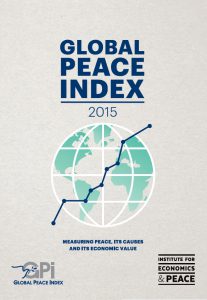Resource Title
Global Peace Index Report 2015: measuring peace, its causes and its economic value
Summary
A statistical analysis of the state of peace in 162 countries over the last nine years. This report provides an insight into trends in peace and conflict, the economic cost of violence, and an assessment of the attitudes, structures and institutions that sustain peaceful societies.
Resource Details
Description
“This is the ninth edition of the Global Peace Index (GPI), which ranks the nations of the world according to their level of peacefulness.
The index is composed of 23 qualitative and quantitative indicators from highly respected sources and ranks 162 independent states, covering 99.6 per cent of the world’s population. The index gauges global peace using three broad themes: the level of safety and security in society, the extent of domestic and international conflict and the degree of militarisation.”
Based on international criteria and up-to-date research, the Report identifies the most peaceful and most violent regions and countries in 2014 and offers a framework and analysis to describe and measure ‘positive peace’.
Highly useful report as it:
- provides a world, regional and country level analysis based on consistent and equally applied criteria and research and ranks them in terms of peacefulness
- includes detailed tables (ideal for research by students etc.), such as violence expenditure
- excellent summative graphics and a series of solid case studies including one on the Middle East.
- a comprehensive bibliography of sources.
- is well-written and is readily accessible and usable.
The report outlines new findings on Positive Peace, highlighting its impact on peace, development and other important societal goals. In societies where Positive Peace is stronger, developmental goals are more likely to be achieved.
“These societies are more resilient when faced with crisis and have fewer grievances. They are more likely to achieve non-violent positive outcomes when faced with resistance movements and are more likely to adapt and make concessions to reconcile grievances. Additionally, Positive Peace is also statistically associated with many other outcomes considered desirable: stronger business environments, better performance on well-being measures, gender equality and better performance on ecological measures.”
Available from:
Download Global Peace Index Report 2015 PDF (7.41MB)
Visit the Institute for Economics and Peace website https://economicsandpeace.org

